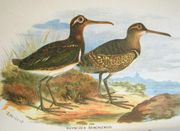
Greater Painted Snipe
Encyclopedia
The Greater Painted Snipe, Rostratula benghalensis, is a species of wader
in the family Rostratulidae. It is found in marsh
es in Africa
, India
, Pakistan
, and South-east Asia (Sulawesi)
 Medium-sized, plump wading bird. Long reddish-brown bill, slightly decurved at tip, and distinct white or pinkish eye patch. Rounded, buff-spotted wings and short tail. White of breast extends up around top of folded wing. The Painted Snipe is not related to the true snipes and differs from them in habits, flight and appearance, being far more colorful and having longer legs than the snipes. It is unusual in showing reversed sexual dimorphism
Medium-sized, plump wading bird. Long reddish-brown bill, slightly decurved at tip, and distinct white or pinkish eye patch. Rounded, buff-spotted wings and short tail. White of breast extends up around top of folded wing. The Painted Snipe is not related to the true snipes and differs from them in habits, flight and appearance, being far more colorful and having longer legs than the snipes. It is unusual in showing reversed sexual dimorphism
; the female is larger and more brightly colored than the male, with the sides of the head, neck and throat a rich chestnut brown, and a distinct black band across the breast; the male is paler and greyer.
Usually found close to the fringes of reed beds along shorelines of marshes, swamps, ponds and streams.
Solitary or in pairs, sometimes in groups of up to 12. Rather shy and retiring, skulking close to the vegetation so that it can retreat to cover if disturbed. When flushed, flies like a rail with legs dangling. Bobs hindquarters on landing and sometimes when walking. Probes for food in the mud. The female initiates courtship and may mate with more than one male. The male incubates the eggs.
theory. Chicks are buff coloured and have black stripes running along their length. Immature birds resemble the male but lack the broken dark band across the breast. Males are also known to carry the chicks to safety under the wings.
The nest is usually a shallow scrape in soft ground, lined with plant material and situated among grass or reeds at the water's edge; sometimes a pad of vegetation or a nest of grass and weeds. The breeding season is between April and July.
Wader
Waders, called shorebirds in North America , are members of the order Charadriiformes, excluding the more marine web-footed seabird groups. The latter are the skuas , gulls , terns , skimmers , and auks...
in the family Rostratulidae. It is found in marsh
Marsh
In geography, a marsh, or morass, is a type of wetland that is subject to frequent or continuous flood. Typically the water is shallow and features grasses, rushes, reeds, typhas, sedges, other herbaceous plants, and moss....
es in Africa
Africa
Africa is the world's second largest and second most populous continent, after Asia. At about 30.2 million km² including adjacent islands, it covers 6% of the Earth's total surface area and 20.4% of the total land area...
, India
India
India , officially the Republic of India , is a country in South Asia. It is the seventh-largest country by geographical area, the second-most populous country with over 1.2 billion people, and the most populous democracy in the world...
, Pakistan
Pakistan
Pakistan , officially the Islamic Republic of Pakistan is a sovereign state in South Asia. It has a coastline along the Arabian Sea and the Gulf of Oman in the south and is bordered by Afghanistan and Iran in the west, India in the east and China in the far northeast. In the north, Tajikistan...
, and South-east Asia (Sulawesi)
Description

Sexual dimorphism
Sexual dimorphism is a phenotypic difference between males and females of the same species. Examples of such differences include differences in morphology, ornamentation, and behavior.-Examples:-Ornamentation / coloration:...
; the female is larger and more brightly colored than the male, with the sides of the head, neck and throat a rich chestnut brown, and a distinct black band across the breast; the male is paler and greyer.
Behaviour
Not a vocal species; the male at times utters a shrill trill, while the female makes a guttural ook sound as well as hissing noises during breeding displays.Usually found close to the fringes of reed beds along shorelines of marshes, swamps, ponds and streams.
Solitary or in pairs, sometimes in groups of up to 12. Rather shy and retiring, skulking close to the vegetation so that it can retreat to cover if disturbed. When flushed, flies like a rail with legs dangling. Bobs hindquarters on landing and sometimes when walking. Probes for food in the mud. The female initiates courtship and may mate with more than one male. The male incubates the eggs.
Reproduction
The females court the males, are polyandrous with males incubating and raising the young as predicted by parental investmentParental investment
In evolutionary biology, parental investment is any parental expenditure that benefits one offspring at a cost to parents' ability to invest in other components of fitness...
theory. Chicks are buff coloured and have black stripes running along their length. Immature birds resemble the male but lack the broken dark band across the breast. Males are also known to carry the chicks to safety under the wings.
The nest is usually a shallow scrape in soft ground, lined with plant material and situated among grass or reeds at the water's edge; sometimes a pad of vegetation or a nest of grass and weeds. The breeding season is between April and July.

